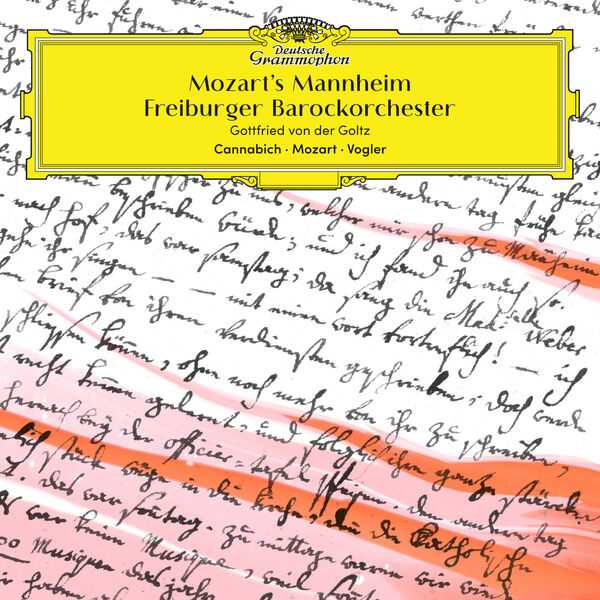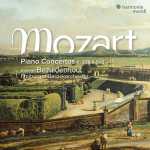

Composer: Johann Christian Cannabich, Christian Danner, Ignaz Holzbauer, Wolfgang Amadeus Mozart, Carl Joesph Toeschi, abbe Georg Joseph Vogler
Performer: Freiburger Barockorchester
Conductor: Gottfried von der Goltz
Format: FLAC (tracks)
Label: Deutsche Grammophon
Catalogue: 4863502
Release: 2023
Size: 1.17 GB
Recovery: +3%
Scan: yes
01. Vogler: Der Kaufmann von Smyrna: Overture
Cannabich: Symphony No. 55 in C major
02. I. Allegro maestoso
03. II. Andante non tanto
04. III. Presto ma non troppo
Danner: Violin Concerto in F major
05. I. Allegro moderato
06. II. Adagio
07. III. Rondeau
Toeschi: Sextet in B flat major
08. Andante grazioso-Allegro
09. Holzbauer: Günther von Schwarzburg: Overture
Mozart: Alcandro, lo confesso – Non so d’onde viene, K294
10. Alcandro, lo confesso
11. Non so d’onde viene
Mozart: Symphony No. 52 in C, K208 / 102
12. I. Molto allegro (After Overture to Il re pastore, K. 208)
13. II. Andantino (After Aria “Intendo, amico” from Il re pastore, K. 208)
14. III. Presto assai
The Freiburger Barockorchester and Deutsche Grammophon launch their new creative partnership with an album of works associated with the celebrated Mannheim court orchestra. The recording captures the spirit of a city whose musical life made a lasting impact on the young Mozart. Mozart’s Mannheim couples little-known gems with works written by Mozart during his formative visit to Mannheim.
The album includes no fewer than four world premiere recordings:
– Christian Cannabich’s Symphony no.55
– Christian Danner’s Violin Concerto in F major
– Carl Joseph Toeschi’s Sextet for flute, oboe, violin, viola, bassoon and cello
– Georg Joseph Vogler’s Overture to Der Kaufmann von SmyrnaMozart’s Mannheim has been carefully curated to give 21st-century listeners an idea of the sound world experienced by Mozart when he visited Mannheim in the late 1770s. The southern German city’s legendary court orchestra made it a go-to destination for 18th-century cultural pilgrims and the Freiburger Barockorchester (FBO) has chosen to paint a musical portrait of Mannheim for its debut Deutsche Grammophon album. Mozart’s Mannheim presents a variety of orchestral and chamber pieces by Cannabich, Danner, Holzbauer, Toeschi and Vogler – including four world-premiere recordings – as well as two key works composed by Mozart while he was in the city.
“The Mannheim court of Elector Carl Theodor was famous for its vast orchestra in which the very best instrumentalists of their day played together,” explains Martin Bail, Dramaturge of the FBO. “That’s why we decided to begin our partnership with DG with music created in Mannheim around the time of Mozart’s visit in 1777-78.”
Dr Rüdiger Thomsen-Fürst of the Forschungszentrum Hof | Musik | Stadt in Schwetzingen, an expert on Mannheim’s orchestra and its composers, followed the evidence trail left by Mozart’s letters to his family and used the insights they contain about his relationship with fellow composers and rivals to shape the FBO’s programme. “Mozart’s correspondence reveals how he encountered the leading musicians of the Mannheim court orchestra,” he notes. “There were those such as Cannabich with whom he became friends, those from whom he remained distant and those such as Vogler for whom he harboured a certain animosity. His letters also tell us something about the music he discovered in Mannheim and the works he wrote or performed there. The music we’ve chosen therefore represents an attempt to allow today’s listeners to hear something of what he heard in his day.”
Having first passed through Mannheim as a touring child prodigy, Mozart returned in October 1777 at the age of 21. He was instantly enchanted by the power and presence of the Mannheim orchestra, which as well as being famed for its exceptional size and virtuosity, was responsible for developing an array of arresting dynamic effects. Mozart remained in the city until the following March, during which time he composed sonatas for violin and keyboard, songs, works for solo piano, concert arias, quartets for strings and wind instruments, and his first concerto for flute and orchestra, among other works.
Mozart’s Mannheim opens with the Overture to Georg Joseph “Abbé” Vogler’s Der Kaufmann von Smyrna as Mozart might have heard it in February 1778, before continuing with Cannabich’s Symphony no.55 in C major, a dazzling display of the tonal shadings and dramatic effects and contrasts that hallmarked the Mannheim sound. Its orchestration includes clarinets, an addition to the woodwind section that particularly impressed Mozart when he heard the orchestra perform. The symphony is followed by Christian Danner’s elegant Violin Concerto, written soon after its composer began taking lessons in Mannheim with Mozart, and played by the FBO’s joint Artistic Director Gottfried von der Goltz.
The outstanding quality of music made by Mannheim composers is further reflected in two strikingly different works: Carl Joseph Toeschi’s Sextet for flute, oboe, violin, viola, bassoon and cello and the Overture to Ignaz Holzbauer’s singspiel Günther von Schwarzburg, a performance of which led Mozart to write to his father Leopold, amazed at “how much fire there is in this music”.
The album is rounded off by two works by Mozart himself. Soprano Nicole Chevalier performs the concert aria Alcandro lo confesso … Non sò d’onde vieni, first performed by Mozart’s future sister‑in‑law Aloysia in early 1778. “With this final aria,” wrote Mozart to his father, “my dear Mlle Weber brought incredible honour both to herself and to me.” Like the aria, his Symphony in C K208/102 was premiered in the home of fellow musician Cannabich. Its first two movements had begun life in 1775 as the Sinfonia and opening aria respectively of the serenata Il re pastore, while the finale was newly composed in Mannheim.
“What Mozart learned in Mannheim cannot be overstated in terms of its value to his later life,” concludes Martin Bail. “After this time, he reached new levels of quality, individuality and originality. The FBO and Deutsche Grammophon have followed Mozart to Mannheim to create a programme of the music he heard and learned from there. What better place to begin our collaboration?”
Formed in 1987 by a group of like-minded students at the internationally renowned Hochschule für Musik Freiburg, the Freiburger Barockorchester stands today among the world’s foremost period-instrument orchestras. The self-governing ensemble is run according to its own carefully defined artistic credo. Like the Mannheim court orchestra of the 1770s, it usually works without a conductor and draws concerto soloists from its own players. Whether performing well-known or newly discovered music, the FBO’s musicians aim to discover the context in which a work was written and what its composer’s intentions were, so as to bring the highest degree of authenticity to their interpretations. Under the joint artistic direction of fortepianist Kristian Bezuidenhout and violinist Gottfried von der Goltz since 2017, it has extended its repertoire in recent seasons to embrace music from the 19th century.
Several recordings have explored the relationship between Mozart and the city of Mannheim, which he visited several times. This Deutsche Grammophon release by the Freiburger Barockorchester and conductor/violinist Gottfried von der Golz may be the best of them. The annotations refer to how Mozart basked in the high regard in which he was held in Mannheim and to how impressed he was with the famed court orchestra there. However, after hearing this release, the listener may be tempted to go even further and assert that the music of Mannheim exerted a strong influence on Mozart in the late 1770s. The entire first half of the program here consists of world premieres, and all of them sound Mozartian. Why? Most of them point toward the big-boned movement structures Mozart loved, even if they don’t expand them as far as Mozart would later in his career. Consider the first movement of Christian Cannabich’s Symphony No. 55 in C major, with its long passages that move only slowly off the home key; one can hear any number of Mozart movements as proceeding from this idea, and one also wants to hear some more of the numerous and almost completely unplayed symphonies of Cannabich. Even less known are the Mannheim composers Georg Joseph Vogler, Christian Danner, and Carl Joseph Toeschi, and their contributions are eminently listenable. Mozart wraps the program up with a recitative and aria and the unnumbered Symphony in C major, K. 208, assembled by the composer from other music; it absolutely fits in here. The performances are idiomatic, and the sound is excellent. A valuable contribution from von der Goltz and company that landed on classical best-seller charts in the spring of 2023.



